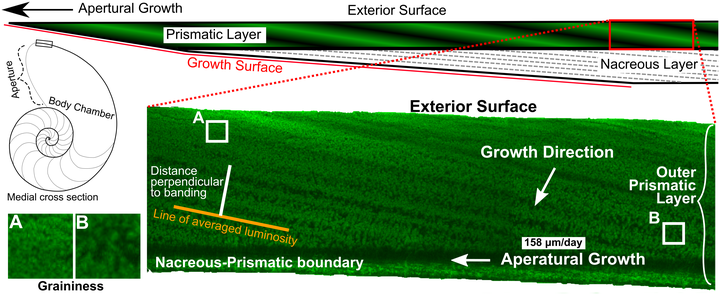 Schematic illustrations of a cut through the medial plane of a Nautilus and full thickness shell wall at the aperture and CLFM image of Nautilus shell showing inclined banding visible by CLFM in the outer prismatic layer relative to actively growing surface of the shell.
Schematic illustrations of a cut through the medial plane of a Nautilus and full thickness shell wall at the aperture and CLFM image of Nautilus shell showing inclined banding visible by CLFM in the outer prismatic layer relative to actively growing surface of the shell.Abstract
Nautilus is often used as an analogue for the ecology and behavior of extinct externally shelled cephalopods. Nautilus shell grows quickly, has internal growth banding, and is widely believed to precipitate aragonite in oxygen isotope equilibrium with seawater. Pieces of shell from a wild-caught Nautilus macromphalus from New Caledonia and from a Nautilus belauensis reared in an aquarium were cast in epoxy, polished, and then imaged. Growth bands were visible in the outer prismatic layer of both shells. The thicknesses of the bands are consistent with previously reported daily growth rates measured in aquarium reared individuals. In situ analysis of oxygen isotope ratios using secondary ion mass spectrometry (SIMS) with 10 μm beam-spot size reveals inter- and intra-band δ 18 O variation. In the wild-caught sample, a traverse crosscutting 45 growth bands yielded δ 18 O values ranging 2.5‰, from +0.9 to -1.6 ‰ (VPDB), a range that is larger than that observed in many serial sampling of entire shells by conventional methods. The maximum range within a single band (~32 μm) was 1.5‰, and 27 out of 41 bands had a range larger than instrumental precision (±2 SD = 0.6‰). The results from the wild individual suggest depth migration is recorded by the shell, but are not consistent with a simple sinusoidal, diurnal depth change pattern. To create the observed range of δ 18 O, however, this Nautilus must have traversed a temperature gradient of at least ~12°C, corresponding to approximately 400 m depth change. Isotopic variation was also measured in the aquarium-reared sample, but the pattern within and between bands likely reflects evaporative enrichment arising from a weekly cycle of refill and replacement of the aquarium water. Overall, this work suggests that depth migration behavior in ancient nektonic mollusks could be elucidated by SIMS analysis across individual growth bands.